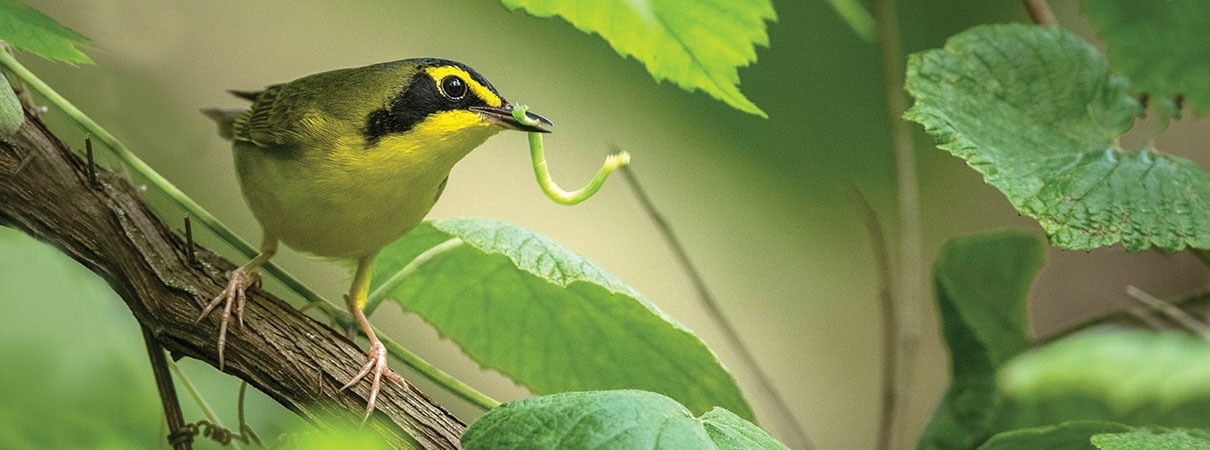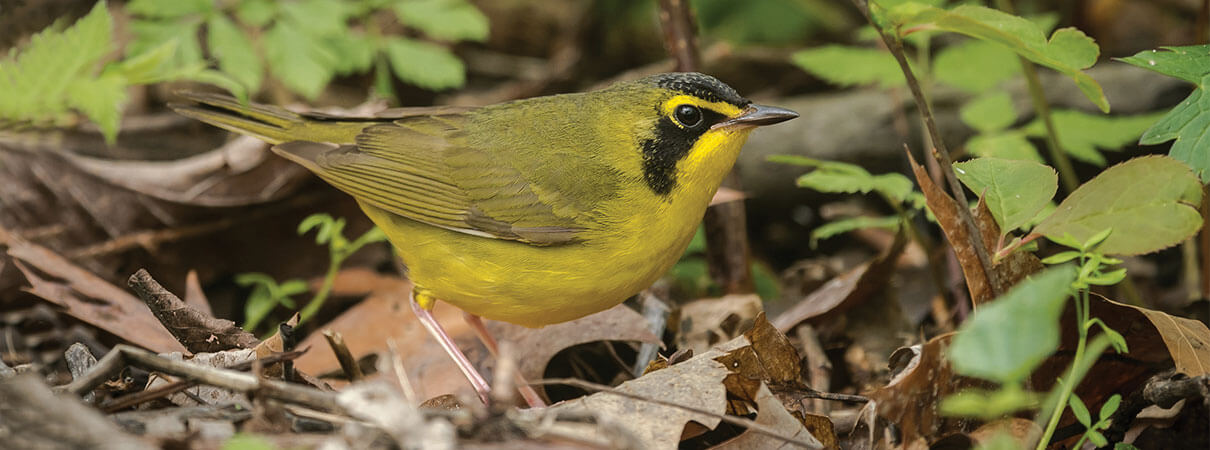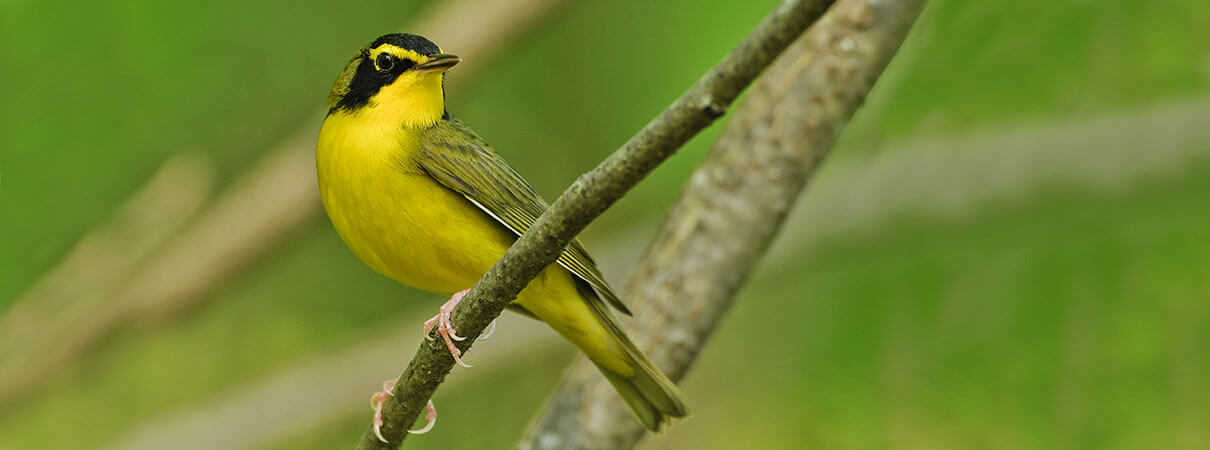Kentucky Warblers in Spring: Finding a Phantom Bird
It may take years for beginning birders to spot a Kentucky Warbler, but only a life's work unlocks this forest phantom's secrets.
A skulker and featherweight world traveler, the Kentucky Warbler is like a marsh rail or a rainforest antbird — dwelling in a world of shadow as we try to peer in.
In spring and early summer, males of this lemon-and-olive, black-masked songbird sing a rich, double-noted turry-turry-turry that recalls somewhat the rollicking notes of its neighbor the Carolina Wren. “Learn the song; ten Kentuckies are heard for every one seen,” advised birding pioneer Roger Tory Peterson. This clarion song beckons birders and the few biologists who dedicate years of fieldwork to this species to tread over increasingly soppy ground to a low, damp, shrub-and-vine-covered pocket of forest. There, after some neck-craning, eye-straining, and mosquito-swatting, the observer may see, at least for a moment, Geothlypis formosa — or, as the scientific name translates, the “beautifully formed earth-finch.”

Kentucky Warbler. Photo by Ray Hennessy/Shutterstock
Diving in Deep
Vickie McDonald has seen more Kentucky Warblers that anyone you'll meet. An Associate Professor of Biology at the University of Central Arkansas, she spent 20 summers in Virginia's Blue Ridge Mountains, as well as some winters in Panama, studying what makes this bird tick. She has studied its behavior — who mates with whom, song types, territories — and conducted one of the first studies tracking post-fledgling dispersal. Her research has tried to answer very basic questions about longevity, return rates to territories, and other aspects of this mysterious bird's life history. That has meant chasing a lot of songs and covering many miles on foot to visit different territories — sometimes six to 12 miles a day.
Getting this “in the weeds” on warblers — mist-netting, measuring, and handling normally secretive subjects — you're bound to learn things that few or no other people have. “One thing that I found and documented with photographs is that the dark mask and crown of a male is not always so dark,” says McDonald. Most bird field guides illustrate males as darker-headed than females, but McDonald found that this coloration varies between individuals. “Just because you've been told the darker one is the male is not necessarily true,” she notes.
McDonald also knows that, despite many dangers, Kentucky Warblers can live a long time. For years, she held the record for re-capture of the oldest-known Kentucky Warbler, believed to be at least nine years old. That record was apparently broken in 2019, when a Kentucky Warbler was re-captured at the Wehle Land Conservation Center in Midway, Alabama. That bird, first banded in
2010, was recaptured in 2016, then again in 2019. Thought to be at least 11 years old, it holds the species' longevity record and has lived about as long as any known wood-warbler. That's an amazingly long run for a bird weighing less than three grapes.

Kentucky Warbler. Photo by Ryan Askren
Innate Real Estate
The Kentucky Warbler was first described and named in the spring of 1810 by a gun-toting, lean, and fatigued Alexander Wilson. The Scottish-born adventurer, who died three years later at the age of 47, covered more than 12,000 miles, amassing the first exhaustive look at American birdlife. In his nine-volume masterwork American Ornithology, Wilson described dozens of new species, including five now bearing his name — a storm-petrel, plover, snipe, phalarope, and warbler — and the Kentucky Warbler, a bird he named for the mostly forested state in which he found it. In those days, Kentucky's frontier was undoubtedly packed with perfect habitat for the bird — damp deciduous forest where plenty of light filters down, nourishing a dense understory of shrubs and vines.
McDonald has spent many days in such ideal habitat, which provides not only plenty of cover but lots of food for the birds. During her years of study, she's carefully watched what adults stuff into their nestlings' eagerly gaped bills. “Adults seek out just about any soft-bodied arthropod,” she says, “essentially, non-flying invertebrates of medium size.” This might include bugs, beetles, caterpillars, and ants. “After fledging, the young ones seek the biggest, fattest, droopiest caterpillars that can be found.”
“Legacy” real estate can be a big factor in warbler match-making: “The best territories, presumably those with less predation and more food, seem to be the most traditional ones,” says McDonald, “those that are occupied again and again, and where older males first appear in spring. But it's not just the same individual coming back to the same territory.”
McDonald thinks that there's something ingrained in the birds that is fixated on location, location, location. “There's something traditional, social, like a loose lekking ground,” she says, referring to the communal sites where displaying male sage-grouse, prairie-chickens, and manakins, among others, vie for prospecting females' attention. “The males show up first; then the first-arriving, perhaps oldest, females show up there to the core, traditional areas first.”
Such allegiance to priority sites raises a flag with McDonald, who frequently calls the species by its bird-banding code name: “There might be something underlying what KEWAs want. Physically, an area may seem to be the same. But maybe it was not occupied before.” For this reason, McDonald believes that prime habitats, with their traditional ties, cannot easily be replaced. “Playing chess games with swaps and trades — you can't just assume a one-for-one or even a two-for-one trade if old places are not there anymore.” And sometimes prime KEWA real estate, even if protected, is not safe….

Kentucky Warbler. Photo by Serge Forcier/Flickr
A Cost That Is Deer
I saw my first Kentucky Warbler in June 1984, on a trail in Great Falls Park in Northern Virginia that was one of the best stakeouts for this species close to Washington, D.C.
Today, the park and trail remain but the breeding Kentuckys are gone. The most recent eBird sighting I found for this spot was during migration almost a decade ago.
On my last visit there, a few years ago, I could see what happened: Gone was the thick understory of shrubs, vines, ferns, and forbs, replaced beneath the mature trees by a thick blanket of invasive Japanese Stiltgrass. Deer had trampled, overbrowsed, and over-grazed the undergrowth, in the process hoof-planting fast-spreading stiltgrass seeds. The resulting habitat modification, commonly seen in forest areas within an hour's drive of Washington, D.C., provides far less cover, few if any nest sites, more vulnerability, and reduced food resources. In other words, it's inhospitable for a bird that nests on or near the ground and needs plenty of hiding places.
Recent studies in the Blue Ridge Mountains and elsewhere confirm that Kentuckys favor areas with low deer density, likely for these reasons.
Luckily, Kentucky Warblers have a large breeding range. Although field guide maps show them as present across much of the East, a detailed map showing 2014 to 2018 eBird data points paints a different picture of their abundance: East of the Appalachians, the overall density of the breeding Kentucky Warbler population is far lower than in the Appalachian foothills and west of the mountains. There, large blocks of habitat with robust populations remain in Arkansas, Missouri, and elsewhere. And certain forest management strategies in these areas benefit this bird species and others (see "READ MORE" below).
But Kentucky Warblers spend almost half the year in the United States. The rest of their lives plays out south of the U.S. border.
READ MORE: Joining The Conservation
The Kentucky Warbler is a lovely bird facing an uncertain future. The landbird conservation network Partners in Flight has the species on its Yellow Watch List of declining birds, noting a 29-percent drop in population between 1970 and 2014. About half of the states where Kentucky Warblers nest list it as a bird of conservation concern.
Fortunately, with the right balance, Kentucky Warblers can thrive in working landscapes, benefiting, for example, from certain forest thinning techniques, sustainable agriculture, and conservation projects on multi-use private, federal, and state lands. ABC is involved in a number of large-scale conservation initiatives benefiting Kentucky Warblers. These programs include:
BirdScapes
BirdScapes are landscape-scale areas identified by ABC that provide habitat to help sustain or recover targeted migratory bird species or populations. On the Kentucky Warbler's wintering grounds these include Guatemala's Conservation Coast, Northern Nicaragua Highlands, Bosawas (also in Nicaragua), and the Yoro Corridor and Agalta-Lost City in Honduras. Some of these areas get funding from the U.S. Fish and Wildlife Service's Neotropical Migratory Bird Conservation Act (NMBCA). Within these BirdScapes and others, ABC and partners work on improving protection of remaining forests, promoting beneficial agroforestry and silviculture (including shade-grown coffee), and habitat restoration projects.
Joint Ventures
An estimated 84 percent of the Kentucky Warbler‘s global population falls within ABC-supported regional partnerships called Migratory Bird Joint Ventures (JVs). JVs bring together local, state, federal, and nongovernmental organizations (including ABC), corporations, and landowners. JVs implement long-term habitat management benefiting many declining migratory bird
populations. Efforts to enhance habitat for the increasingly scarce Cerulean Warbler, for example, also benefit Kentucky Warblers.
Southern Wings
This program collaborates with ABC and fosters participation by state fish and wildlife agencies in the conservation of migratory birds beyond U.S. borders. Conservation of migration and overwintering sites is a priority for the program, and over 11 years, Southern Wings has brought together 30 state fish and wildlife agencies with conservation partners in many parts of
the Neotropics. Among the BirdScapes benefiting from Southern Wings support are Guatemala's Conservation Coast and the El Jaguar Reserve within the Northern Nicaragua Highlands BirdScape. Both sites are important to Kentucky Warblers. At El Jaguar, Southern Wings has supported the development of tree nurseries, habitat restoration, and outreach and education activities with local landowners, as well as ABC and El Jaguar efforts to monitor migratory birds via a newly installed MOTUS tower that tracks radio-tagged birds.
Sustainable Forestry Initiative
ABC works with at least a dozen companies that sustainably manage millions of acres of working forests certified to the standards of the Sustainable Forestry Initiative, Inc. Those standards include a commitment to conserve biodiversity, with special consideration for riparian areas, native vegetation, and thinning of forests to promote understory development. These types of
management activities benefit Kentucky Warblers and other birds such as Wood Thrushes and Swainson's Warblers.
Kentuckys in the Tropics
As is true of many Neotropical migrants, the Kentucky Warbler's winter range is concentrated in a far smaller area than its breeding range, mostly from southern Mexico through Central America's humid and semi-humid lowlands and foothills. Small numbers winter in Colombia and Venezuela, and the species is very rarely recorded during winter in the Caribbean. Deforestation has been extensive in most parts of the bird's winter range.
On the wintering grounds, Kentucky Warblers haunt the forest understory, both in mature and advanced second-growth forest. There, beneath luxuriant cover, they adopt some interesting behaviors. Wintering Kentucky Warblers join resident birds and other migrants in mixed feeding flocks, and, from Mexico to Colombia, they have been seen attending army ant swarms. The famed waves of ravenous ants fan out across the forest floor, sending before them fleeing insects, spiders, centipedes, scorpions, tiny frogs and lizards, and other prey. A variety of birds wait in the wings to snap up the startled creatures.
In a study published in The Wilson Journal of Ornithology — a publication and society named for the man who named the bird — the Kentucky Warbler was the most frequent migrant recorded at army ant swarms at a study area near Monteverde, Costa Rica, both in percentage of army ant raids attended and individual birds seen. In all, the 2010 study recorded the Kentucky Warbler at just over 20 percent of the swarms, with one individual each at ten different “events.” Migrant Wilson's Warblers and Wood and Swainson's Thrushes also attended, although they were recorded less frequently. Six other migrant warbler species showed up, but only in once-or-twice cameos.

Kentucky Warbler. Photo by Ed Scheider/Shutterstock
A Swarming Personality
The dynamics within energetic swarm feeding frenzies are only recently coming to light. In many cases, there seems to be a surprisingly tolerant ambiance. Among the resident “regulars” attending the Costa Rica ant swarms were the resident Orange-billed Nightingale-Thrush (the most frequently recorded species), Lesson's Motmot, Rufous-and-white Wren, and Ruddy Woodcreeper.
Some of these nonmigratory species are much larger than warblers. How can a Kentucky Warbler stand its ground in these feeding parties?
The same authors published a 2014 study in The Wilson Journal of Ornithology that again focused on the Monteverde area. They found no evidence that birds of different species competed at ant swarms. (Inter-species competition has been observed in other regions, however.)
Other studies find likely benefits to foraging in these mixed flocks, including safety from predators and “here's the swarm” signals alerting birds to these quickly materializing but widely scattered events. The Lesson's Motmot and some other species specialize in monitoring army ant bivouacs — mobile nests the colonial insects make by balling themselves in a mass protecting the queen and eggs. Based on more than a decade of observations in Costa Rica, Drexel University professor Sean O'Donnell indicated in a 2017 Biotropica article that the motmot and other bivouac-checking species not only notify but tolerate generalist ant followers including the Kentucky Warbler.
But that doesn't mean there isn't competition within species: Kentucky Warblers and other migrants, including Wood Thrushes, are territorial even on their wintering grounds, chasing off others of their species. That may explain why usually only one Kentucky Warbler or Wood Thrush is seen per ant swarm.
Amid the Foliage: Fight and Flight
As spring peaks, Kentucky Warblers are on territory and then on eggs. Because we mostly just hear them sing, it's easy to overlook the effort these birds take to raise their next generation. McDonald has seen many dramas play out on Kentucky territories. “There can be direct competition between Worm-eating and Hooded and Kentucky Warblers,” she says. “The Kentucky is usually the most aggressive — less tolerant than some other species. But I've seen a Worm-eating Warbler steal food out of the bill of a foraging Kentucky. A Kentucky would win a fair competition.”
McDonald has also seen a Kentucky tussle with a Carolina Wren. But more ominous dangers lurk: nest-robbing jays and crows, raccoons, and opossums, Cooper's Hawks, and the ever-vigilant Brown-headed Cowbird, a blackbird that lays eggs in Kentucky and other songbird nests, so the hosts will raise cowbird young, to the detriment of their own.
Despite adults' territorial tussles, in the high-stakes game of songbird survival, McDonald thinks being able to vanish is key: “I believe that one of the attributes that a KEWA pair, a female presumably, is looking for in a male's territory is not so much exactly where the nest will be, but rather its proximity to escape havens for the young when they leave the nest.” When danger strikes, fledglings “go for the darkest, tiniest little crawl space, and are incredibly hard to find,” she says.
For most observers, Kentucky Warblers are phantoms, mostly heard and not seen. In many areas, though, even their telltale song is fading. Our challenge as wildlife habitat stewards is to ensure this bird doesn't make the ultimate disappearing act, vanishing for good.
 | Howard Youth is ABC's Senior Writer/Editor, and is the author of Field Guide to the Natural World of Washington, D.C. |


















































